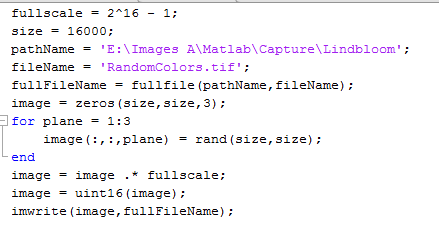We got pretty good results with round trip conversions from sRGB to Adobe RGB and back using a smallish 16-bit image and a 16-bit image with all the 8-bit sRGB colors. Before I declare victory, I decided to see what happened with a lot more 16-bit colors. I wrote a Matlab script to generate a 256 mega-pixel image populated with uniformly distributed 16-bit colors:
I brought the image into Photoshop and assigned the sRGB profile to it. The, using absolute colorimetric rendering intent, with no black compensation and no dither, I took it to Adobe (1998) RGB and back.
When I compared it to the original image in Matlab, I got:
- an average error of 0.0020 CIELab DeltaE
- standard deviation of 0.0049
- worst-case error of 0.2121.
This is not as good as we got doing the conversions in Matlab, but it is good enough that photographer should have to worry about damaging their images by making this set of color space conversions.
From sRGB to ProPhotoRGB and back:
- average error of 0.0030 CIELab DeltaE
- standard deviation of 0.0026
- worst-case error of 0.0900.
From sRGB to Lab and back:
- average error of 0.0040 CIELab DeltaE
- standard deviation of 0.0033
- worst-case error of 0.0875.
The two latter conversion pairs produce results entirely consistent with the first set of numbers.

Leave a Reply